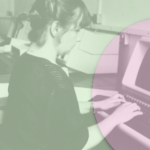What is IP PBX?
In recent years, almost all the leading manufacturers of switching equipment have produced office PBXs ( PBX, Private branch exchange or Private business exchange – office PBX or PBX ) with the ability to transmit voice over data channels, including via the Internet via SIP ( Session Initiation Protocol ). They began to call IP PBX.
SIP (Session Initiation Protocol) is a technology that allows you to make a telephone conversation through the Internet or a local network of the enterprise. When using this technology, a direct point-to-point connection is established between subscribers. Thanks to SIP technology, you can make video calls.
Conventional office PBXs use channel switching technology: when receiving a call on a copper line, the PBX switches it to internal numbers in the office. IP-PBX uses packet switching technology, i.e. A call to the PBX arrives via a data network channel and is then redirected to a special telephone that supports SIP connection. As a SIP-phone, you can use not only a stationary device, but also a softphone installed on a computer or mobile phone. The latest models of smartphones with the Android operating system already have built-in support for receiving and making calls using the SIP protocol.
2. Scope of IP-PBX
The appearance of IP-PBX is associated with the rapid development of computer technology and the emergence of corporate data networks and, as a result, the demand for equipment that allows the use of the same communication channels for the transmission of voice traffic, data, fax messages and video information. Modern IP-PBXs convert speech to standard IP packets and send them over the communication channel, where they are transmitted along with data packets.
IP packets are blocks of information transmitted over the Internet or the local network of an enterprise.
Thanks to the use of Internet channels for transmitting voice traffic, connecting an office PBX has become only a matter of setting up authentication data on the side of the telecom operator and the subscriber who has the IP-PBX installed. Avoiding traditional wires also allowed subscribers to change rented premises painlessly since when moving from office to office, existing organization numbers are saved, and only an Internet channel is required to connect the exchange.
In the case of using IP-PBX in the company for the organization of telephone communication between several offices, it is possible to significantly reduce the cost of using the channels of fixed-line operators. The connection of several PBXs via IP channels is usually cheaper than through other protocols (ISDN BRI, PRI, E&M and others). Also, thanks to the use of IP-technologies, modern PBX subscribers can be located outside the office, connecting to the office PBX from anywhere from any device that supports voice transmission using the SIP protocol.
3. Benefits of IP PBX
- Almost an unlimited number of lines and subscribers – unlike ordinary office PBXs and mini-PBXs, which have the maximum capacity of external lines or internal ports of IP-PBX can expand almost unlimitedly, and both external lines and internal subscribers can be connected in various ways;
- IP-PBX allows you to combine the company’s divisions and branches located in different places (another city or country) into a single telephone network , while all subscribers, regardless of their location, will be subscribers of one PBX, which will make all calls between branches free;
- Using IP-PBX, you can organize an interactive voice menu (IVR) or the so-called “smart secretary”, with which you can process incoming calls in automatic mode;
- IP-PBX allows you to organize a system for automatically receiving faxes and forwarding to e-mail; The ability to organize a voice mail system;
- The control interface of the IP-PBX is accessible through a web browser , which provides ease of management and change of the necessary parameters;
- On the basis of IP-PBX, the implementation of video telephony systems is possible , which will allow employees to communicate not only with voice, but also provide visual contact.
- IP-PBX provides all the functions of modern office PBXs – call forwarding (according to various custom rules), call hold, call pickup, group call, etc.
- Different call forwarding options both between internal subscribers and to mobile phones of employees located outside the office;
- Centralized recording of conversations on the IP-PBX server allows you to save information about all conversations made;
- Conferencing – conferences with connecting both internal and external subscribers;
- The ability to set restrictions on the implementation of long-distance or international calls for various groups of subscribers;
- The system easily integrates with CRM-systems , databases, etc .;
- Based on IP-PBX, you can organize a call processing center (call-center or contact center);
In addition, on the basis of IP-PBX you can organize a unified communications system (unified communications), which will allow employees of your company to stay always in touch.
You May Also Read Asterisk Vs FreeSwitch
4. How to Select IP PBX?
The IP-PBX has a packet switching function, which means that such a PBX is a small computer with its own operating system, processor and memory. As a rule, a special version of the Linux operating system with a proprietary software package providing call control and additional services is installed in the IP-PBX. As a rule, Asterisk software PBX is used.
Asterisk is a full-featured software PBX. It can work on operating systems such as Linux, BSD, Windows and OS X and provides you with all the features that a regular PBX and even more have. The functioning of Asterisk is based on protocols that provide voice over IP-based networks (Internet protocol) and, thanks to this, this PBX can work with almost any equipment for IP telephony that uses standard protocols for VOIP, while using relatively inexpensive Hardware.
Thus, the main thing you need to pay attention to when choosing an IP-PBX is its performance. The performance of stations operating on the basis of packet switching technology is determined by the number of simultaneous connections. Depends on how many people can talk on the phone at the same time.
You also need to pay attention to the size of the memory installed in IP-PBX. The number of minutes saved for voicemail and recorded conversations will depend on the amount of memory. If there is a shortage of it, old recordings of conversations and voicemail will be deleted.




